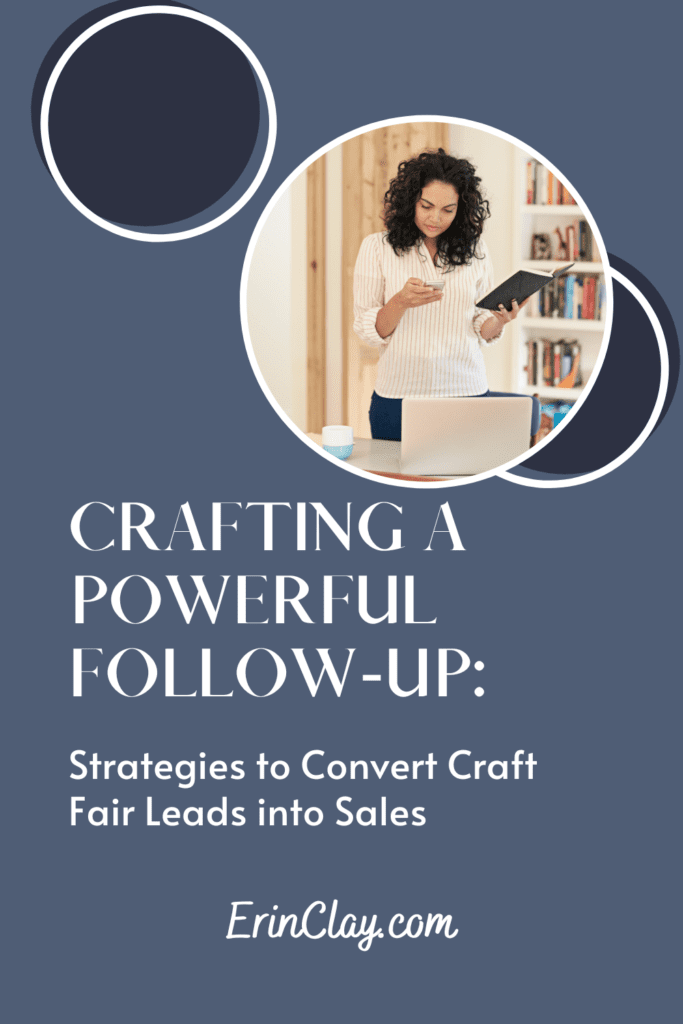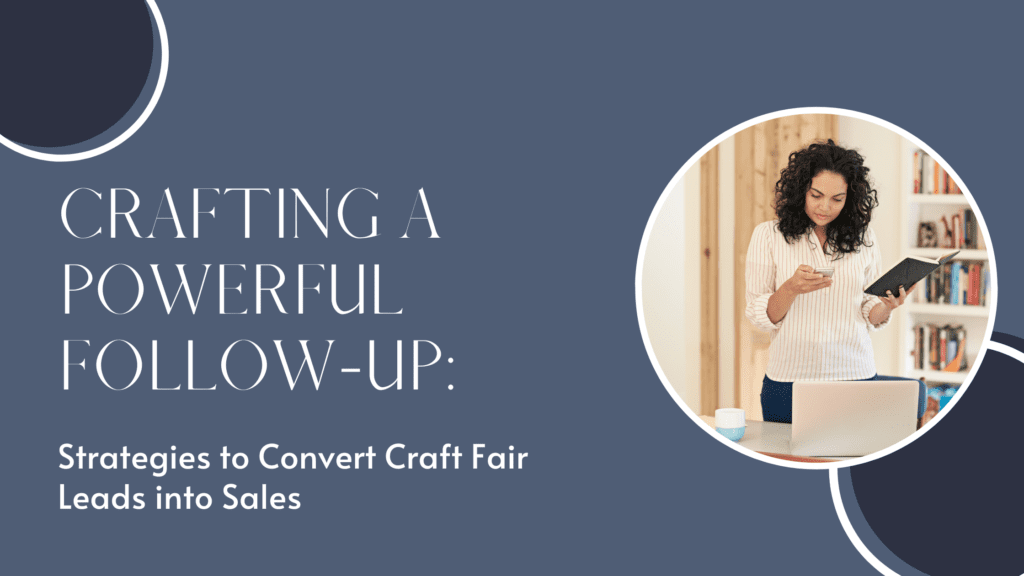Are you tired of lugging boxes of handmade crafts to craft fairs only to walk away with little to no sales? You’re not alone. But what if I told you that the secret to success lies in your follow-up strategy? By implementing expert tips and techniques, you can turn those “just looking” leads into loyal customers. This article will dive into the strategies you need to convert craft fair leads into sales. From organizing your leads to staying top-of-mind, you’ll learn how to craft a powerful follow-up plan that helps you build long-lasting relationships with potential customers. Let’s get started.
Organizing Your Leads for Maximum Impact
One key factor in successfully converting craft fair leads into sales is organizing your leads for maximum impact. Once you have collected contact information from potential customers, it’s essential to categorize and prioritize those leads to create an effective follow-up plan. This will allow you to tailor your approach to each individual lead, increasing the likelihood of a successful sale. In the next section, we’ll dive into how to create an effective follow-up plan to help turn those leads into loyal customers.

Creating an Effective Follow-Up Plan
Once you’ve collected contact information from potential customers at a craft fair, it’s crucial to have a plan for following up. Creating an effective follow-up plan will not only help you convert leads into sales, but it will also establish a foundation for building long-lasting relationships with customers. The first step in creating a follow-up plan is organizing your leads for maximum impact. This means prioritizing leads based on their level of interest, potential buying power, and any additional information you may have gathered during your conversation.
Once you have organized your leads, it’s time to craft a personalized follow-up message that resonates with each customer. This is where the power of personalization comes into play. By tailoring your approach to each lead, you can show that you value their unique needs and preferences. Use the information you gathered during your conversation to create a message that speaks directly to their interests and needs. This could include highlighting specific products they showed interest in or offering a discount for their first purchase.
Remember, the key to a successful follow-up plan is to be genuine and authentic in your communication. Avoid using generic templates or mass messaging that can come across as impersonal. Instead, focus on building a personal connection with each lead by using their name and referencing any specific details from your conversation.
In the next section, we’ll explore the power of personalization in more detail and discuss strategies for creating a follow-up message that resonates with each lead.

The Power of Personalization
To truly stand out from other vendors, creating a personal connection with each lead is essential. You can achieve this by taking note of their name and any specific details from your conversation and using this information to craft a follow-up message that resonates with them. Personalization shows that you value their time and attention, and it sets the foundation for a lasting relationship.
In the next section, we’ll discuss how to stay top-of-mind with your leads and ensure that you’re the first vendor they think of when they’re ready to make a purchase.
Staying Top-of-Mind with Your Leads
To maximize your potential sales, staying top-of-mind with your leads is crucial even after the craft fair is over. This means following up with them promptly and personally, using the information you gathered during your conversation to craft targeted messages that resonate with their needs.
One effective way to stay top-of-mind with your leads is by using email marketing. Consider sending a monthly newsletter that showcases your latest products or promotions and includes helpful tips or insights related to your brand. This approach keeps your brand in front of your leads and positions you as a valuable resource and industry expert.
Another approach is to leverage social media to stay connected with your leads. Consider connecting with them on LinkedIn or Twitter and sharing relevant content that they may find valuable. This can help keep your brand top-of-mind while demonstrating your commitment to building meaningful relationships.
Overall, staying top-of-mind with your leads is essential to the follow-up process. By using personalized messaging and strategic touchpoints, you can ensure that your brand is the first they think of when they’re ready to purchase. In the next section, we’ll dive deeper into the importance of timeliness in follow-up and how it can impact your conversion rates.

The Importance of Timeliness in Follow-Up
Staying top-of-mind with potential customers after a craft fair is crucial in converting leads to sales. However, it’s not enough to connect with them on social media or send them a generic follow-up email. The importance of timeliness in follow-up cannot be overstated. Research shows that the longer you wait to follow up with a lead, the less likely they are to convert. In fact, according to a study by InsideSales.com, 50% of leads go with the vendor that responds first.
This is why it’s crucial to have a follow-up plan before the craft fair even begins. Determine how you will prioritize and segment leads, and set up a system for follow-up communication. It could be as simple as sending a personalized email within 24 hours of the fair, or you could consider sending a handwritten note or making a phone call to the most promising leads.
The key is to be prompt, personal, and persistent in your follow-up efforts. Show your leads that you value their time and interest and are committed to building a meaningful relationship. Doing so will increase your chances of converting leads to sales and building a loyal customer base.
Now that we’ve covered the importance of timeliness in follow-up, let’s explore how to measure and optimize your follow-up strategy for even greater success.

Measuring and Optimizing Your Follow-Up Strategy
Now that we have established the fundamentals of an effective follow-up strategy, it’s time to look closely at the metrics and tools that can help you optimize your efforts. By analyzing your follow-up data, you can identify what works and what doesn’t, and adjust your approach accordingly.
One key metric to track is response rates. How many of your leads are responding to your follow-up emails or calls? This can help you determine if your messaging is resonating with your audience or needs adjustments. Additionally, tracking the time it takes for a lead to respond can provide insight into their level of interest and engagement.
Another critical metric to consider is conversion rates. How many of your leads are ultimately making a purchase? This can help you determine your follow-up strategy’s effectiveness and identify improvement areas.
To optimize your follow-up strategy, consider utilizing email automation and customer relationship management (CRM) software tools. These tools can help you streamline your follow-up process, track your metrics, and personalize your communications.

In conclusion, measuring and optimizing your follow-up strategy is vital to achieving greater success in converting leads to sales. By analyzing your metrics and utilizing the right tools, you can continually improve your approach and build stronger relationships with potential customers.
Crafting an effective follow-up plan is essential if you want to turn craft fair leads into sales. By organizing your leads effectively and creating a personalized follow-up plan, you can stay top-of-mind with potential customers and build long-lasting relationships. Remember to be timely, track your progress, and optimize your strategy. With these expert tips, you can create an effective follow-up plan that helps you achieve craft fair success. As the saying goes, “The fortune is in the follow-up,” so don’t let those leads slip away!
Want to know if you are ready to turn your craft hobby into a craft business? I’ve created a free checklist of the 5 Things to Have Before Starting A Craft Business so you can turn your hobby into a craft business. I created this checklist because I often see DIY Crafter and Handmade Crafters struggling with knowing how to get started as a business. If you can relate to this, my 5 Things To Have Before Starting A Craft Business is explicitly designed to help you know exactly what it takes to start a handmade business and get to do what you love, crafting. So if you’d like to take advantage of this free download.

Don’t forget to follow me on social media!
WANT TO WORK WITH ME ON A DEEPER LEVEL? HERE IS HOW YOU CAN DO THAT
- Be A Vendor Booth Rockstar – 5 strategies to help you be a prepared and confident seller at your next Craft Fair.
- 5 Things to Have Before Starting A Craft Business – Download my Free Cheat Sheet & Turn Your Hobby Into A Business!
- 100+ Small Business Ideas – A list of over 100 ideas for small businesses that you can start from your home. This helps you brainstorm and come up with the perfect business for your skills and personality.
- How To Use Instagram To Grow Your Local Business – This cheat sheet helps you use Instagram’s power and influence to reach your local audience and grow your business.
- Launch Your Dream Business – This 5-day course helps you set up your business correctly and gets you started building your dream business.
- Make Your Business Soar – A Premium online course that guides you on the step-by-step journey of how to market your business.


